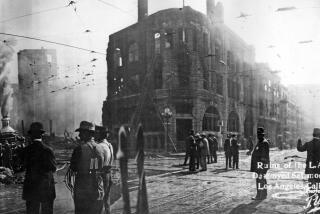He Made Doctor See Things Differently
- Share via
My first distinct memory of Jim Murray was when I was working for the Louisville Times in the 1970s, and he was in town covering the Kentucky Derby for the Los Angeles Times. Just like that, he outraged thin-skinned Louisvillians by writing a widely quoted column trashing their city.
What they didn’t realize was that it wasn’t personal, that Jim was an instinctive urban critic who did the same thing in lots of places where he covered sports, leaving behind a residue of outraged citizens and, I’m positive, infinitely more admirers of how stylishly he expressed himself in print. His fans--they were the multitudes.
You could not be a columnist at the Los Angeles Times without being influenced by Jim and wanting, on some level, to write just like him.
Fat chance.
Some years ago, I wrote a TV column in this paper that a reader likened to one of Jim’s columns. “You’re another Murray,” he said. Although I was enormously flattered, it was absolutely the worst thing I could have heard. I became one of those singles hitters who hits a home run, is then convinced he’s a slugger and thereafter swings for the fences, only to keep grounding out or popping up.
There was only one Murray.
I frequently tried imitating him. Yet each time I knew in my heart that I was--to borrow one of Jim’s own descriptions that I never forgot--”tap-dancing while sitting down.” Jim, of course, was always up on his feet, being the top-hatted Fred Astaire of newspaper prose, ever stepping out with his baby, which was sports.
How well could he write?
It was only Wednesday that I was being examined by a respected ophthalmologist with a specialty in retinal surgery. Aware that I wrote for The Times, he proceeded to tell me that a newspaper columnist had been largely responsible for the direction he took in his medical career about the time he was deciding to specialize. I hoped he meant me.
Like, sure.
Instead, he told me it was a column he had read in The Times 20 years ago, a column that so moved him that he decided to become a “retina man,” a column by Jim Murray.
It was Jim’s famous eye column about his retinal detachment that had such a profound impact on Joel Corwin.
“I found his description of his problem so moving,” Corwin recalled again Monday, “that it made me realize how significant blindness could be in a person’s life. And I felt I wanted to help people who had retinal problems so that they would not go blind.”
A sports man inspiring a medical man.
The great irony is that despite his vision problems, Jim Murray continued to see better than anyone else. His legacy of words is evidence.
More to Read
Go beyond the scoreboard
Get the latest on L.A.'s teams in the daily Sports Report newsletter.
You may occasionally receive promotional content from the Los Angeles Times.










